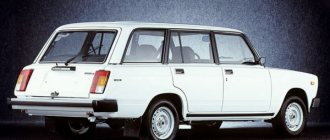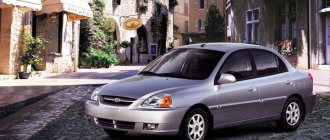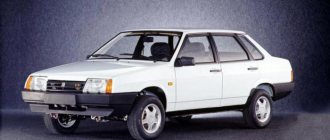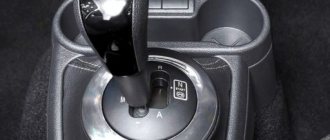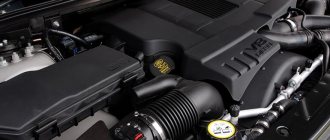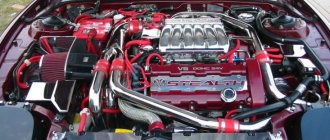History of VAZ 21099 Samara – Automotive Directory
VAZ-21099 “Samara” Export name – Lada Samara Years of production: from 1990 to 2004.
The VAZ-21099 model is a four-door sedan produced by the Volga Automobile Plant, the final model of the Samar family. It differs from its older sisters in its overall length, which, due to an increase in the rear overhang, has increased by 200 mm in relation to other cars in the family. VAZ-21099 has been produced by AvtoVAZ since 1990. Before the release of the LADA 110 family of cars in 1996, the “ninety-ninth” was the most prestigious and popular. Currently, the VAZ-21099 is still considered one of the prestigious domestic models and is still highly rated on the market as a convenient and practical car. VAZ 21099 is a front-wheel drive sedan with a 1.5-liter gasoline engine and a 5-speed manual transmission. The VAZ-21099i model is also produced with an economical 1.5 liter engine with distributed fuel injection (injector), which meets international standards for the toxicity of the exhaust system. The following modifications are available for cars with carburetor engines - “standard” (VAZ-21099-00), “norm” (VAZ-210992-01) and “luxury” (VAZ-21099-02), for cars with distributed fuel injection - “standard” (VAZ-21099-20), “norm” (VAZ-210992-21) and “luxury” (VAZ-21099-22). Externally, the car has an original radiator trim, hood and front fenders without a plastic “mask”. The interior of the “ninety-ninth” is equipped with a new panel (popularly called “high”) with a tachometer in the instrument cluster. Subsequently, this “high panel” was adopted by the entire Samara family. The panel equipment includes an original instrument cluster, backlit switches that provide electric control of windows and door locks. The on-board monitoring system notifies the driver about the performance of individual vehicle components. Complete with the panel, a steering column with an adjustable tilt angle is used. Comfortable seating for the driver and passengers is ensured by the use of new seat padding material and height adjustment of the seat belt attachment points. Installing fog lights optimizes the vehicle's lighting performance in inclement weather. The advantages of VAZ-21099 cars are undoubtedly high speed performance, good handling and stability on various types of roads. This sedan is perfect for both representatives of the “middle class” for trips around the city, and for regular trips with the family to the country. The car is quite representative and versatile. The model has not been produced by the Volzhsky Automobile Plant since 2004. In the Samar model range, it was replaced by the improved VAZ 21150 sedan.
VAZ-2109 - model history, photos, prices
The five-door hatchback VAZ-2109 (aka Lada Samara, aka Lada Sputnik) began to be produced in 1986, a year later than the G8.
The state price of the car is 8900 rubles. The car was equipped with a 1.3-liter engine producing 65 hp. s., the gearbox was four-speed, and since 1989 - five-speed. The VAZ-21091 with a 1.1-liter engine (54 hp) was made especially for export.
Since 1990, modernized “nines” with the so-called “long wing” and a different radiator grille began to roll off the assembly line. In the mid-1990s, the car began to be equipped with 1.5-liter engines with a carburetor (70 hp) or an injection system (78 hp). Cars with a VAZ-415 rotary piston engine with a power of 120 were also produced in small quantities. l. With.
Hatchback VAZ-21093, 1990–2005
In 1996-1998, the Lada Samara Baltic was assembled at the Finnish Valmet Automotive plant - a slightly improved version for the European market with a more modern front panel, for which an airbag was even offered as an option.
Hatchback Lada Samara Baltic GL, 1986–1993
In the last years of production, the “nine” was assembled not in Tolyatti, but at the RosLada plant in Syzran (until 2005). They were produced in Ukraine until 2011.
The 2109 hatchback was replaced by a modernized model with the index 2114.
VAZ-2109 “Sputnik Samara”
Since 1987, production of VAZ-2109 models in a five-door hatchback body began. Compared to its fellow eight, the Sputnik/Lada Samara VAZ-2109 was considered a more respectable family car. This was affected by the presence of 5 doors and, as a result, a much less expressive appearance.
Since 1988, the ninth model, as well as modifications of this car (VAZ-21091 and VAZ-21093) have become the most popular front-wheel drive VAZ models. An even more successful modification of the ninth model was the VAZ-21093, which was produced in 1990.
If you fold the rear seats, the car could easily transform into a cargo-passenger version. It could be used as a station wagon. In the basic versions of the VAZ-2109, transversely mounted carburetor 1.3-liter four-cylinder engines with a power of 65 horsepower were installed. With these characteristics, a fully loaded car accelerated to 100 km/h in 18 seconds. The maximum possible speed is 156 km/h. The VAZ-21093 model was equipped with 1.5-liter engines (VAZ-21083) with a power of 72 horsepower. The VAZ-21093i model came with injection engines with a working volume of 1.5 liters. Plus, a modification of the VAZ-21091 was made, which was equipped with engines with a volume of 1.1 liters. Since the 90s, Luxury vehicles have been equipped with a newer instrument panel, which had a tachometer and a trip computer. And the newest development was a motor with a distributed fuel injection system.
In 1995, the front of the body was restyled. As a result, the radiator grille no longer melted. The last cosmetic modernization was carried out in 1997, however, the car’s equipment remained virtually unchanged.
The VAZ-2109 model and its modifications ceased production in 1997. This was due to the cessation of production of engines of the predecessor VAZ-2108.
Modifications
Over the years of production of the “ninety-nine”, various modifications were released. So, in addition to the one and a half liter engine, engines with a displacement of 1.3 liters with a carburetor or injector were installed - this was modification 210993. VAZ 21099 cars were exported under the names Lada Forma, Lada Sable, Lada Sagona, Lada Samara Saloon.
An all-wheel drive version was released - Lada Victory, equipped with a forced 1.6 liter engine. All-wheel drive provided the car with amazing maneuverability, but due to the high cost, this modification was not in demand, and therefore its production was curtailed.
VAZ-21099
When the VAZ-21099 sedan model appeared on the assembly line in 1990, the production process of the Samara model family was completed. The rear overhang was increased, which significantly lengthened the car in comparison with other cars in the family. This model had a radiator lining that stood out, which was quite original, and the front fenders and hood were made without a plastic mask. The interior of the car itself was equipped with a new panel with a tachometer. A little later, these solutions were applied to the entire family of Samara models.
VAZ 21099 is a car with front-wheel drive. Body – sedan. The car is equipped with 1.5-liter engines, as well as 5-speed manual transmissions. VAZ-21099i came with injection engines with a volume of 1.5 liters. Since the beginning of the production of these cars, modifications have been produced in different years, both with carburetor engines and injection engines with working volumes of 1.3 liters VAZ-210993 and 1.5 liters VAZ-21099.
The following options were provided: for cars with carburetors - “norm” (VAZ-210992-01), “standard” VAZ-21099-00 and “luxury” VAZ-21099-02; for cars with an injector - “norm” VAZ-210992-21, “standard” VAZ-21099-20 and “luxury” VAZ-21099-22.
Technical characteristics (VAZ-2109 / VAZ-21099):
| Manufacturer: | Volzhsky Automobile Plant. | |
| Years of production: | 1984-1997, 1984-2003, 1984-1997 / 1990-2004, 1997-2004 | |
| Dimensions (L x W x H), mm | - / 4205 x 1650 x 1402 | |
| Wheelbase, mm | — | |
| Body type | hatchback/sedan | |
| Number and arrangement of cylinders | 4/L4 | |
| Engine capacity, l | 1.3, 1.1, 1.5/1.5, 1.5i | |
| Curb weight, k | — / 970 | |
| Total weight, kg | 1425 / 1395 | |
| Engine power, l. With. , at rpm | 65/5600, , 72 (78-i)/5600 // 70/5600, 78/5400 | |
| type of drive | 4x2, front | |
| Supply system | carburetor (i-injector) / carburetor (i-central injection) | |
| Brake system | front disc, rear drum | |
| Front suspension | Independent T. McPherson | |
| Rear suspension | trailing arm | |
| Acceleration dynamics 0-100 km/h, s | 15.6 / 16 | |
See also:
- Volkswagen New Beetle
- Opel Ascona A
- Daewoo Lanos
- History of the road sign
- BMW E65-E66
- Airless tires
- BMW Z8
DESIGN FEATURES
The VAZ-21099 was initially distinguished from other models of the Samara family by the front part of the body with long wings, without a plastic “beak” in the front and a longer hood, a new radiator grille, and the instrument panel became gray, unlike the brown panels on other Samaras. . Subsequently, these innovations were transferred to the entire Samara family for the sake of unifying the models.
Installation of gas equipment
Installation of LPG on a VAZ is possible due to the presence of injectors. Some people install gas equipment without thinking about whether it is really necessary. In fact, HBO is a wonderful addition for VAZ, but it also has its drawbacks.
Installing an LPG does not make sense if the driver does not travel very far, because the main advantage of this equipment is savings when traveling long distances. For example, if a car travels 100 km a day, then installing LPG will reduce fuel costs by almost 2 times, but if the mileage is 20 km a day, then there will not be much savings.
The main disadvantages of HBO for the car and its owner are the following:
- loss of dynamics;
- decent cost of equipment installation;
- complication of the fuel supply system (as a result - more breakdowns);
- weighting the car.
However, it is necessary to note some advantages of HBO.
- Reducing the likelihood of detonation. No matter how strange it may sound, it is true. Gasoline is more likely to ignite than gas.
- Less harmful emissions.
If after installing the LPG the car jerks strongly, contact a specialist immediately! This behavior of the car can be a sign of many serious problems.
Where is the fuel pump located on the VAZ-21099 injector
Removing and installing a gasoline pump (PG) is not a difficult job and does not require extensive plumbing experience or high qualifications. But if you don’t have to look for a fuel pump on carburetor cars for a long time (it is located on the engine, under the hood), then a beginner may not find it on the injector on the first try. Where is the fuel pump located on the VAZ-21099 sedan injector? Let's figure it out step by step:
- we move the front seats in the car forward as much as possible to free up space in the rear;
- open the rear left door of the car, find a small hinge on the rear sofa, which is located at the junction of the “seats” approximately in the middle of the cabin;
- pull the loop up, thereby raising the back of the lower seat;
- under the carpet we see the gas tank flap;
- unscrew the two fastening screws, remove the hatch and find the fuel pump underneath.
From Sputnik to Samara.
Two ways to implement the project immediately emerged - the first was proposed by designers V. Pashko and V. Kryazhev and involved the creation of a sedan based on a new front-wheel drive platform (VAZ-2110 project), and the second involved the creation of a new classic family, which was supposed to replace the “classic” » VAZ-2105/2104/2107 (project VAZ-2112). A compromise was reached only by the approval of two projects, so work was now carried out in two directions, of which the classics were the priority in the early days. Creating a sedan based on the VAZ-2109 came down not just to “attaching a trunk,” but also to a new solution for the front end. The fact is that the previous sharp “mask” with a “beak” looked contrasting against the background of the smooth connection of the trunk with the middle part. At first, designer Pashko tried to go the already beaten path, that is, attach four round headlights to the body, as on the VAZ-2103 and 2106, but it turned out that this option looked poorer and gave less quality light than with the basic rectangular headlights. This was clearly visible on the model of the future car, on which one part was made with a “long” wing and hood, but with two headlights, and the other with a basic headlight and a “mask”, and both parts had the notorious “beak” in the middle. .
The result of the long work was an artistic council held in July 1983, at which the fate of the future sedan was to be decided. The VAZ-2110 and VAZ-2112 projects were presented to the council on a competitive basis. The Minister of Automotive Industry Polyakov liked the VAZ-2110 more, which he expressed in a fatal phrase for the car: “Better a bird in the hand than a pie in the sky.” The essence of this remark was that the creation of a “new classic” did not consist in creating a car based on Zhiguli units, but in developing a car “from scratch,” while the VAZ-2110 project involved only relatively small changes in the body architecture , and the entire technical base was taken from the already mastered “nine”. After this artistic council, technologists began to master the production of a new body, and the VAZ-2112 project was postponed until “better times.” At this time, designer Vladislav Pashko had already finally settled on “long” wings, standard block headlights and a plastic radiator grille. After all, one of the terms of the technical specifications was to make the new sedan the most expensive and luxurious car, replacing the VAZ-2106 in this field. Unlike other Sputniks, in addition to external differences, it had a new dashboard with an added tachometer, new signal lamps, space for a stereo radio, etc.
Until 1985, in the technical documentation you could see the index 2110, but then why is the car index still VAZ-21099? If engineers had assigned the car the index 2110, then it would have had to undergo a full cycle of technical tests, but the engineers decided to use the trick that they had once used on the VAZ-2106, only in reverse. After all, in fact, the “six” was just a modification of the “troika”, but in order to report to the state for the release of a new car, it was assigned the index 2106. Now, in order not to go through a full test cycle for the new car, the front-wheel drive sedan was assigned the index VAZ-21099, that is, just a modification of the “nine” to undergo a shortened test cycle for modifications.
The trade name of the car deserves special mention. By the end of the 80s, realizing that the name “Sputnik” was not taking root in the market, it was decided to replace it with the export name – Samara. It was assumed that it would be written in Cyrillic for the domestic market, but everyone tried to read the English “Camapa” instead of the Russian “Samara”. Therefore, the name of the car was never written in Cyrillic on nameplates.
The VAZ-21099 car was produced at AvtoVAZ from 1990 to 2004 and from 2004 to 2011 in Ukraine. In Russia, over 14 years of production, 953 thousand cars were produced, and on April 20, 1992, the VAZ-21099 was lucky enough to become the 14 millionth car produced at VAZ. In the 90s, it was the 99th that was the most prestigious and modern domestic passenger car, which it remained until the advent of the new generation of VAZ-2110 cars.
